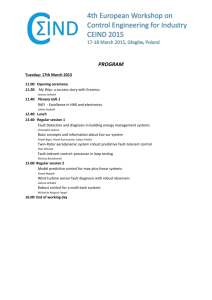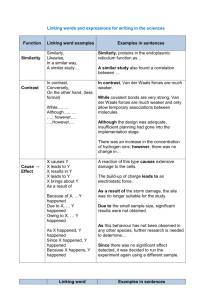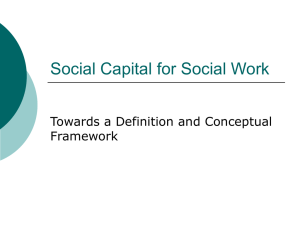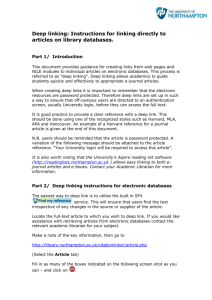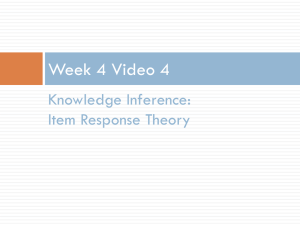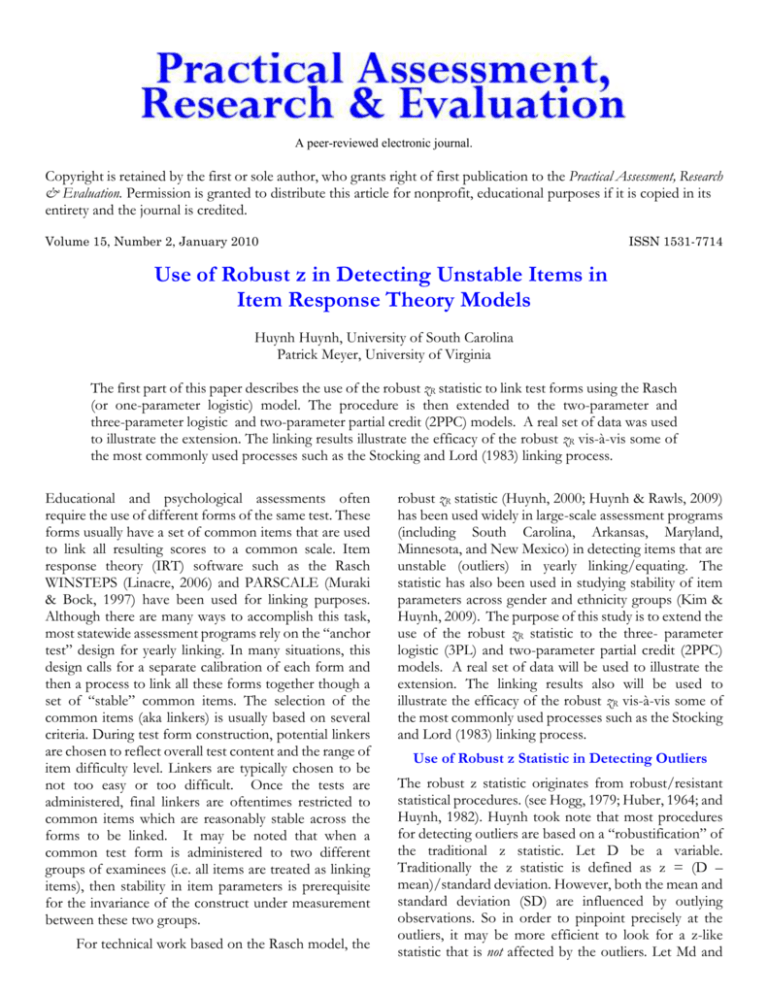
A peer-reviewed electronic journal.
Copyright is retained by the first or sole author, who grants right of first publication to the Practical Assessment, Research
& Evaluation. Permission is granted to distribute this article for nonprofit, educational purposes if it is copied in its
entirety and the journal is credited.
Volume 15, Number 2, January 2010
ISSN 1531-7714
Use of Robust z in Detecting Unstable Items in
Item Response Theory Models
Huynh Huynh, University of South Carolina
Patrick Meyer, University of Virginia
The first part of this paper describes the use of the robust zR statistic to link test forms using the Rasch
(or one-parameter logistic) model. The procedure is then extended to the two-parameter and
three-parameter logistic and two-parameter partial credit (2PPC) models. A real set of data was used
to illustrate the extension. The linking results illustrate the efficacy of the robust zR vis-à-vis some of
the most commonly used processes such as the Stocking and Lord (1983) linking process.
Educational and psychological assessments often
require the use of different forms of the same test. These
forms usually have a set of common items that are used
to link all resulting scores to a common scale. Item
response theory (IRT) software such as the Rasch
WINSTEPS (Linacre, 2006) and PARSCALE (Muraki
& Bock, 1997) have been used for linking purposes.
Although there are many ways to accomplish this task,
most statewide assessment programs rely on the “anchor
test” design for yearly linking. In many situations, this
design calls for a separate calibration of each form and
then a process to link all these forms together though a
set of “stable” common items. The selection of the
common items (aka linkers) is usually based on several
criteria. During test form construction, potential linkers
are chosen to reflect overall test content and the range of
item difficulty level. Linkers are typically chosen to be
not too easy or too difficult. Once the tests are
administered, final linkers are oftentimes restricted to
common items which are reasonably stable across the
forms to be linked. It may be noted that when a
common test form is administered to two different
groups of examinees (i.e. all items are treated as linking
items), then stability in item parameters is prerequisite
for the invariance of the construct under measurement
between these two groups.
For technical work based on the Rasch model, the
robust zR statistic (Huynh, 2000; Huynh & Rawls, 2009)
has been used widely in large-scale assessment programs
(including South Carolina, Arkansas, Maryland,
Minnesota, and New Mexico) in detecting items that are
unstable (outliers) in yearly linking/equating. The
statistic has also been used in studying stability of item
parameters across gender and ethnicity groups (Kim &
Huynh, 2009). The purpose of this study is to extend the
use of the robust zR statistic to the three- parameter
logistic (3PL) and two-parameter partial credit (2PPC)
models. A real set of data will be used to illustrate the
extension. The linking results also will be used to
illustrate the efficacy of the robust zR vis-à-vis some of
the most commonly used processes such as the Stocking
and Lord (1983) linking process.
Use of Robust z Statistic in Detecting Outliers
The robust z statistic originates from robust/resistant
statistical procedures. (see Hogg, 1979; Huber, 1964; and
Huynh, 1982). Huynh took note that most procedures
for detecting outliers are based on a “robustification” of
the traditional z statistic. Let D be a variable.
Traditionally the z statistic is defined as z = (D –
mean)/standard deviation. However, both the mean and
standard deviation (SD) are influenced by outlying
observations. So in order to pinpoint precisely at the
outliers, it may be more efficient to look for a z-like
statistic that is not affected by the outliers. Let Md and
Practical Assessment, Research & Evaluation, Vol 15, No 2
Page 2
Huynh & Meyer, Detecting Unstable IRT Item Parameters
IQR be the median and inter-quartile range. For the
normal distribution, the IQR is equal to 1.35 × SD or SD
= 0.74 × IQR or 0.74(IQR). With the quantity
0.74(IQR) emulating the standard deviation, a robust
version of the traditional z statistic can be taken as the
ratio zR = (D – Md)/[0.74(IQR)]. When the D values
come from a normal distribution, the robust zR statistic
follows (asymptotically) a normal distribution with zero
mean and unit standard deviation. A level of significance
(two-tailed alpha) may be selected and a positive critical
value z* may be set. Items with a robust zR smaller than
z* in absolute value will be declared “stable” and other
items with a robust zR greater than or equal to z* in
absolute value will be declared as “unstable.” It may be
noted that some traditional definitions of “outliers” can
be framed within the robust zR context. For example,
Agresti and Finlay (2009; p. 54) suggest that an
observation is an outlier if it falls more than 1.5(IQR)
above the upper quartile or more than 1.5(IQR) below
the lower quartile. Assuming that the median is
equidistant from the upper and lower quartiles, it can be
verified that the above definition corresponds to the
critical value z* = 2.7.
Use of Robust zR in Detecting Unstable Items
in the Rasch Model
Now let R1 and R2 be the Rasch item difficulties
obtained from two separate calibrations. There are two
sets of Rasch item difficulties for the linkers. Let D = R1
– R2 and zR be the robust statistic associated with each D
discrepancy. The South Carolina (SC) linking protocols
(2001) calls for two quality indices for Rasch linking:
ratio (RSD) of the standard deviations of R1 and R2 and
the correlation (CORR) between R1 and R2. Under
perfect conditions for linking, the two sets of Rasch
difficulties differ by a constant; thus the optimal values
for CORR and RSD are exactly 1. However, due to
sampling fluctuations in the calibration process, these
values tend to depart from the optimal values. The SC
protocol for “acceptable linking results” calls for two
criteria: (a) the correlation CORR to be at least .95 and
(b) the RSD to be within .9 and 1.1. The next paragraph
summarizes the justifications provided by Huynh (2009)
for these benchmark values.
According to Huynh (2009), the benchmark value
for CORR is a result of a study by Yen (1987) who found
that the correlation between the true value of the item
location parameter and its estimate was better than 0.97
in many situations. Within the context of classical test
theory, the correlation between true and estimated
values can be treated as a validity coefficient (rval)
whereas the correlation between two estimated values
can be treated as a reliability coefficient (rrel). Since
2
. Since rval is at least 0.97,
rval rrel , we have rrel rval
the other coefficient rrel is at least (0.97)2 or about 0.95.
Also according to Huynh, the two bounds for the ratio
RSD are the results of the significance test that the
population value of this ratio is one. When the standard
deviations of R1 and R2 are equal (i.e. when RSD = 1),
Pearson correlation between the quantities (R1 + R2) and
(R1 - R2) is exactly zero. The traditional t test for the null
hypothesis (Ho) of zero correlation can be used to check
that the hypothesis that RSD is equal to 1. Assuming a
correlation of 0.95 between R1 and R2 and at the 5%
level of significance, the null hypothesis that true value
of RSD is 1 is acceptable if the observed value of RSD is
between 0.9 and 1.1.
When both criteria for “acceptable linking results”
are satisfied, then all items are treated as “stable” and all
potential linkers are used in the linking process.
However, if one of the criteria does not hold, then some
very unstable items will be deleted, starting with items
with largest robust zR statistic. (The zR statistics are
computed only once.) This process is stopped when
either the criteria are met or 20% of potential linkers
have already been deleted. Huynh noted that, in
assessment situations like the South Carolina Basic Skills
Assessment Program (BSAP), each test has several
strands (subtests), each with about five items, and it
would not be desirable to delete more than one item
(20%) for each subtest.
Extension of Methodology Based on Robust z to
3PL Models
Let a1 and b1 be the slope and location of a given item
in the 3PL model for one group of students (first
calibration). Let a2 and b2 be the same parameters for
another group of students (second calibration). Linking
the second set of item parameters to the first set requires
determination of two constants A and B that set the
following two transformations:
a2 Aa1 , and
b2
(b1 B )
.
A
Note that these transformation equations do not
involve the pseudo-chance (“c”) item parameter. When
the two sets of calibrated item parameters are perfectly
linked, the two constants A and B are identical for all
linkers. However, due to sampling variations, the
Practical Assessment, Research & Evaluation, Vol 15, No 2
Page 3
Huynh & Meyer, Detecting Unstable IRT Item Parameters
equations usually do not hold for all these items. So a
statistical process has to be used to find to constants A
and B that fit (in some statistical sense) the calibrated
parameters of all items. Once the fitting constants A and
B are found, then can be used to find the estimated
parameters of items what are not part of the linking
items.
There are a variety of methods to fit the linking
constants A and B to the calibrated item data of the
linkers. Among them are the Mean-Mean, Mean-Sigma,
Haebra, and Stocking-Lord methods (Haebara, 1980;
Loyd & Hoover, 1980; Marco, 1977; Stocking & Lord,
1983). A new method that is based on robust zR statistics
for both the “a” (slope) and “b” (location) parameters is
described next.
The general process of the robust zR method is
described as follows. Equation 1 can be written as:
log( A) log(a2 ) log(a1 ) . By writing R1 = log(a1) and
R2 = log(a2), it can be seen that the robust zR procedure
described for the Rasch model can be extended to
identify items that are unstable in the “log (a)” (slope)
parameter and needs to be deleted in the linking process.
The value of log(A) can then be taken as the mean of the
discrepancy log(a2) - log(a1) of all surviving linkers. The
value of A will then be computed via the formula A =
exp[log(A)]. Applying this A value to Equation 2 for all
linkers that have survived so far, Equation 2 now
becomes B Ab2 b1 . By writing R1 = b1 and R2 =
Ab2, it can be seen again that the robust zR procedure
described for the Rasch model can be extended to
identify items that are unstable in the “b” (location)
parameter and needs to be deleted in the linking process.
Those that are stable in location may then be used to
find the linking constant B. This constant is the mean of
the discrepancy (Ab2 - b1) taking over all surviving
linking items.
As noted at the beginning of this section of the
paper, the linking constants A and B are defined
theoretically using the slope (“a”) and location (“b”)
item parameters. The robust zR does not rely on the
pseudo-chance item parameter (“c”), and conduct the
data analysis sequentially, first with the slope (“a”) and
then follow this up with the location (“b”) parameter. It
may be noted that the “c” parameters are hard to
estimate, especially when the sample size is small. In fact,
in a number of situations, the “c” parameter has to be
fixed at a certain value or certain range to allow to
calibration process to converge. So it seems to make
sense to set aside the “c” parameter in fitting the linking
constants A and B to the item data. It may also be noted
that there are more sampling fluctuations for the slope
(“a”) than for the location (“b”) estimates. This seems to
justify the use of the robust zR for the slope parameter
first.
Extension to Mixed-Format 2PPC Items
Although this expression was developed for 3PL binary
(multiple-choice) items, it can also be applied to partial
credit items that follow a two-parameter partial credit
(2PPC) model (Muraki, 1992, 1993). It may be noted
that a 2PPC item with k score categories can be explicitly
defined as (k-1) conditional 2PL binary items. The j-th
conditional binary item is the “item” that has only (j-1)
and j as scores. (see Masters, 1982, for a formulation of
conditional items in the Rasch model.) All conditional
binary items have identical slope. The location
parameter of each conditional item is often called
“threshold” parameters in IRT software such as
PARSCALE (Muraki & Bock, 1997).
As for a 3PL model, for a set of 2PPC linking items,
the robust zR procedure starts with detecting items that
are unstable along the slope dimension and need to be
set aside in the linking process. Then the robust zR
procedure is applied to detect any threshold that is
unstable along the location dimension and needs to be
deleted. Theoretically only thresholds that are unstable
need to be deleted from the calibration process.
However, operational testing programs such as the
PACT of South Carolina delete an entire item even if it
has only one unstable threshold. It seems justified in the
sense that one threshold is only one part of the item;
therefore if it is “unstable” then the entire item should
be considered as “unstable.”
For the illustrative purposes of this paper, the
software PARSCALE was used to calibrate the test for
each group, setting the prior distribution to be the unit
normal distribution for each group. Mean/mean,
mean/sigma, Haebara, and Stocking-Lord linking
constants, A and B, were obtained via the software
STUIRT (Kim & Kolen, 2004) using item parameter
estimates from PARSCALE. Equating constants
obtained from the robust zR method were compared to
those obtained by the mean/mean, mean/sigma,
Haebara, and Stocking-Lord procedures.
An Illustration
The performance of the robust z procedure will be
illustrated using a set of archival data from a large-scale
state assessment program. The data came from the
administration of a math test to 5th grade students in
Practical Assessment, Research & Evaluation, Vol 15, No 2
Page 4
Huynh & Meyer, Detecting Unstable IRT Item Parameters
2006. The math test has 40 multiple-choice items and
two constructed response items (with four score
categories 0, 1, 2, and 3). Group 1 (N = 4045) is
comprised of one-third of all male students who had free
or reduced priced lunch. Group 2 is comprised of
one-third of all female students who had to pay their
lunches (N = 3692). As can be seen from Table 1, these
two groups differ considerably in terms of ability.
Table 1: Descriptive Statistics
Student
Group
N
Mean
SD
Alpha
Group 1
4045
21.09
8.22
.86
Group 2
3692
28.67
8.30
.87
PARSCALE was used to estimate the item
parameters for each group separately. Each calibration
set the mean at zero and the standard deviation at one.
The items parameters (a1, a2; b1, b2; and c1, c2) for Group1
and Group 2 are reported in the Appendix A. Items
with ID from 1 to 40 are for the 40 multiple-choice
items. Data listed for the codes 41A, 41B, and 41C are
the common slope and threshold parameter for the three
non-zero scores 1, 2, and 3 of the first CR items.
Similarly, data listed for the codes 42A, 42B, and 42C are
the common slope and threshold parameter for the three
non-zero scores 1, 2, and 3 of the second CR items.
The first set of robust z statistics were first
computed for the difference Adiff log(a1 ) log(a2 ) .
Using the cut score 1.96 for the robust zR, two items (ID
= 26 with zR = 4.261; and 38 with zR = -2.88) were
found to be “unstable” along the slope dimension.
Based on the remaining 44 data items, the linking
constant (on the log scale) is -0.19609, which is
transformed back to A = 0.822 on the original slope
scale.
The second set of robust zR statistics was computed
for the difference Bdiff Ab2 b1 using the 44 “stable”
items. Using also the cut score 1.96 for the robust zR, six
items were found to be “unstable” along the location
dimension. They are listed as follows: ID = 17 (zR =
2.624); ID = 21 (zR = -2.37); ID = 28 (zR = -2.58); ID =
33 (zR = 2.399); ID = 35 (zR = 3.924); and ID = 44 (zR =
1.987). Based on the remaining “stable” items, the
linking constant was found to be B = 1.072.
Appendix B lists a sample SAS program for the
robust z analysis.
For illustration purposes, the software STUIRT was
also used to find the linking constants A and B for the
same set of data. Table 2 reports the results of various
linking methods.
Table 2: Results of six linking processes
Method
A
B
Mean/Mean
0.823
1.165
Mean/Sigma
0.770
1.130
Haebara
0.802
1.036
Stocking-Lord
0.823
1.078
Robust z
0.822
1.072
It is interesting to see that the robust zR results are
almost identical to those obtained from the
Stocking-Lord procedure, yet the robust zR method is
computationally much simpler than the Stocking-Lord
procedure. This finding applies only to this data set and
should be considered as suggestive of an interesting
possibility that needs further research.
Educational Importance
IRT models are widely used linking educational
assessment. The robust zR statistic has proved useful in
detecting unstable items in the Rasch model. The
statistic is intuitively appealing and simple to use. This
paper extends the robust zR to the 3PL binary items and
2PPC partial credit items. An illustration based on real
data indicates that the linking constants A and B
obtained from the robust zR procedure are strikingly
similar to those obtained from the well-known
Stocking-Lord procedure. This observation applies only
to this data set and should be considered as suggestive of
an interesting possibility that needs further research.
References
Agresti, A., & Finlay, B. (2009). Statistical methods for the social
sciences, 4th Ed. Upper Saddle River, NJ:
Pearson-Prentice Hall.
Haebara, T. (1980). Equating logistic ability scales by a
weighted least squares method. Japanese Psychological
Research, 22(3), 144-149.
Hogg, R. V. (1979). Statistical robustness: One view on its
use in applications today. The American Statisticians, 33,
108-115.
Huber, P. J. (1964). Robust estimation of a location
parameter. Annals of Mathematical Statistics, 35, 73-101.
Practical Assessment, Research & Evaluation, Vol 15, No 2
Huynh & Meyer, Detecting Unstable IRT Item Parameters
Huynh, H. (1982). A comparison of four approaches to
robust regression. Psychological Bulletin, 92, 505-512.
Huynh, H. (2000, June). Guidelines for Rasch Linking for PACT.
Memorandum to Paul Sandifer on June 18, 2000.
Columbia, SC: Available from Author.
Huynh, H. (March 22, 2009). The Golden Numbers in Rasch
Linking Protocol. Personal Communication to Technical
Advisory Committee on Rasch Linking Protocols.
Huynh, H, & Rawls, A. (2009). A comparison between robust
z and 0.3-logit difference procedures in assessing
stability of linking items for the Rasch model. In Everett
V. Smith Jr. & Greg E. Stone (Eds.) Applications of Rasch
Measurement in Criterion-Referenced Testing: Practice Analysis to
Score Reporting. Maple Grove, MN: JAM Press.
Kim, D. H., & Huynh, H. (2009). Transition from
paper-and-pencil to computer-based testing: examining
stability of Rasch latent trait across gender and ethnicity.
In Everett V. Smith Jr. & Greg E. Stone (Eds.)
Applications of Rasch Measurement in Criterion-Referenced
Testing: Practice Analysis to Score Reporting. Maple Grove,
MN: JAM Press.
Kim, S., & Kolen, M. J. (2004). STUIRT: A computer
program for scale transformation under unidimensional
item response theory models [Computer software and
manual]. Retrieved from
http://www.education.uiowa.edu/casma/computer_pr
ograms.htm#irt.
Page 5
Linacre, J., M. (2006). A user's guide to
WINSTEPS/MINISTEP Rasch-model computer programs.
Chicago: www.winsteps.com.
Loyd, B. H., & Hoover, H. D. (1980). Vertical equating using
the Rasch model. Journal of Educational Measurement, 17(3),
179-193.
Marco, G. L. (1977). Item characteristic curve solutions to
three intractable testing problems. Journal of Educational
Measurement, 14(2), 139-160.
Masters, G. N. (1982). A Rasch model for partial credit
scoring. Psychometrika, 47(2), 149-174.
Muraki, E. (1992). A generalized partial credit model:
Application of an EM algorithm. Applied Psychological
Measurement, 16(2), 159-176.
Muraki, E. (1993). Information functions of the generalized
partial credit model. Applied Psychological Measurement,
14(4), 351-363.
Muraki, E., & Bock, R. D. (1997). PARSCALE: IRT item
analysis and test scoring for rating scale data [Computer
software]. Chicago: Scientific Software.
Stocking, M. L., & Lord, F. M. (1983). Developing a common
metric in item response theory. Applied Psychological
Measurement, 7(2), 201-210.
Yen, W. M. (1987). A comparison of the efficiency and
accuracy of BILOG and LOGIST. Psychometrika, 52,
275-291.
Practical Assessment, Research & Evaluation, Vol 15, No 2
Page 6
Huynh & Meyer, Detecting Unstable IRT Item Parameters
APPENDIX A
Item Calibration Data for Group 1 and Group 2
ID
1
2
3
4
5
6
7
8
9
10
11
12
13
14
15
16
17
18
19
20
21
22
23
24
25
26
27
28
29
30
31
32
33
34
35
36
37
38
39
40
41A
41B
41C
42A
42B
42C
a1
a2
b1
b2
c1
c2
0.729
0.846
0.909
0.818
0.742
0.890
1.741
0.907
1.487
1.228
0.672
1.007
1.016
0.776
0.921
0.550
0.624
0.984
0.506
0.594
0.687
0.541
0.691
0.843
0.530
0.462
1.007
0.825
0.608
1.177
0.900
0.861
0.843
1.404
0.446
1.014
1.632
0.831
1.560
0.798
0.561
0.561
0.561
0.745
0.745
0.745
0.650
0.782
0.816
0.787
0.611
0.888
1.192
0.589
1.211
0.742
0.526
0.690
0.996
0.816
0.781
0.507
0.378
0.976
0.473
0.364
0.585
0.566
0.511
0.718
0.354
1.080
0.840
0.865
0.528
0.814
0.555
0.701
0.530
1.220
0.344
0.966
1.044
0.358
1.192
0.615
0.486
0.486
0.486
0.737
0.737
0.737
1.585
0.635
-0.378
-0.100
-0.195
0.749
1.246
1.016
-0.234
0.537
0.070
1.985
1.101
-0.742
0.463
-0.060
0.477
1.084
-2.340
1.068
-0.055
-1.045
1.859
0.645
-0.689
-2.583
1.922
0.709
0.499
1.973
0.104
0.809
0.640
0.247
0.820
1.837
2.129
1.012
1.774
0.095
0.784
-0.113
1.166
3.687
2.506
-0.001
0.676
-0.525
-1.749
-1.092
-1.619
-0.406
-0.132
0.006
-1.352
-0.872
-1.242
0.873
0.239
-2.038
-0.487
-1.372
-1.492
0.214
-4.537
0.220
-0.686
-2.394
0.747
-0.467
-3.629
-5.000
0.927
0.305
-0.839
1.270
-1.618
-0.091
-1.228
-1.019
-1.453
1.090
1.743
-1.436
1.024
-1.358
-0.539
-1.489
-0.052
2.599
1.250
-1.209
0.134
0.304
0.267
0.176
0.215
0.194
0.267
0.159
0.095
0.197
0.089
0.272
0.229
0.159
0.162
0.100
0.259
0.167
0.000
0.242
0.323
0.000
0.196
0.189
0.000
0.000
0.334
0.538
0.125
0.511
0.192
0.353
0.103
0.241
0.245
0.118
0.155
0.132
0.215
0.148
0
0
0
0
0
0
0.110
0.316
0.161
0.149
0.145
0.200
0.243
0.059
0.081
0.075
0.028
0.267
0.242
0.189
0.184
0.121
0.000
0.170
0.000
0.151
0.383
0.000
0.195
0.177
0.000
0.000
0.352
0.647
0.116
0.501
0.000
0.286
0.000
0.248
0.064
0.150
0.126
0.000
0.187
0.007
0
0
0
0
0
0
Practical Assessment, Research & Evaluation, Vol 15, No 2
Huynh & Meyer, Detecting Unstable IRT Item Parameters
Page 7
APPENDIX B
Sample SAS Program for Robust z Analysis for Slope and Location Parameters
%let CV = 1.96;
Data raw;
Input
ID $ a1 a2
a1log = log(a1);
a2log = log(a2);
Adiff = a2log-a1log;
Kode = 1;
Cards;
b1
b2 ;
* Datelines are here;
;
proc univariate data=raw noprint ; var Adiff; output out=summary Median= MD Mean=Mean
Qrange=IQR;
data new1; set summary; kode=1;
data new2; merge raw new1; by kode;
data new3; set new2; zrobust=(Adiff-MD)/(0.74*IQR);
code ="A-unstable";
if abs(zrobust) le &CV then code ="A-stable";
proc print data=new3 noobs; var ID a1 a2 a1log a2log Adiff zrobust code;
format a1 a2 a1log a2log Adiff zrobust 5.3;
run;
data new4; set new3; if code="A-stable";
proc means data=new4 noprint; var Adiff; output out=LC1 mean=AlogCon;
proc print data=LC1; var AlogCon;
data LC2; set LC1; Kode=1;
Acon=exp(AlogCon);
proc print data=LC2; var Acon;
data new5; merge new4 LC2; by Kode;
data new6; set new5; Bdiff=b1-Acon*b2;
keep ID Kode a1 a2 b1 b2 Bdiff;
proc univariate data=new6 noprint ; var Bdiff; output out=summary2 Median= MD Mean=Mean
Qrange=IQR;
data summary3; set summary2; kode=1;
data new8; merge new6 summary3; by kode;
data new9; set new8; zrobust=(Bdiff-MD)/(0.74*IQR);
code ="B-unstable";
if abs(zrobust) le &CV then code ="B-stable";
proc print data=new9 noobs; var ID b1 b2 Bdiff zrobust code;
format b1 b2 Bdiff zrobust 5.3;
data new10; set new9; if code="B-stable";
proc means data=new10; var Bdiff;
run;
Citation
Huynh, Huynh & Meyer, Patrick (2010). Use of Robust z in Detecting Unstable Items in Item Response
Theory Models. Practical Assessment, Research & Evaluation, 15(2). Available online:
Practical Assessment, Research & Evaluation, Vol 15, No 2
Huynh & Meyer, Detecting Unstable IRT Item Parameters
http://pareonline.net/getvn.asp?v=15&n=2.
Authors
Huynh Huynh
College of Education
University of South Carolina
Columbia, SC 29208.
Email: hhuynh [at] mailbox.sc.edu.
J. Patrick Meyer
Curry School of Education
University of Virginia
P.O. Box 400277
405 Emmet Street South
Charlottesville, VA 22904.
Email: meyerjp [at] virginia.edu
Page 8

